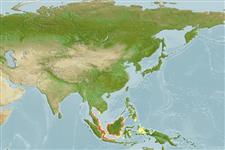Пластиножаберные (акулы и скаты) (sharks and rays) >
Myliobatiformes (Stingrays) >
Dasyatidae (Stingrays) > Hypolophinae
Etymology: Pastinachus: Latin, pastinaca = a sting ray (Ref. 45335); solocirostris: Name from Latin 'solocis' meaning rough or bristly and 'rostrum' for snout, referring to the unusually rough texture of the snout..
More on authors: Last, Manjaji & Yearsley.
Environment: milieu / climate zone / depth range / distribution range
экология
морской; солоноватоводный демерсальный. Tropical
Western Pacific: Malaysian Borneo and Indonesia.
Length at first maturity / Size / Вес / Возраст
Maturity: Lm 32.0, range 28 - 36 cm
Max length : 45.0 cm WD самец/пол неопределен; (Ref. 58048); 44.6 cm WD (female)
Краткое описание
определительные ключи | морфология | морфометрия
A small species with the following diagnostic characters: acute snout, angle less than 110°, covered to apex with enlarged denticles; disc length 94-101% WD; head length 47-51% WD; preoral length 21-25% WD; distance between nostrils 9-11% WD; distance between first gill slits 20-25% WD; tail moderately compressed above the midbase of the ventral cutaneous fold, width 0.7-0.9 times its height; ventral fold slender, its length 1.1-1.3 times WD, 32-41 times its depth below its midbase; ventral fold depth 1.8-2.4 times tail height at its midbase; distance from cloaca to sting 0.9-1 in precloacal length; 1-3 nuchal thorns, largest pearl-shaped; pectoral fin radials 113-120; monospondylous vertebral centra 35-38 (Ref. 58027).
Found most abundant near the coast in regions of high riverine outflow. Largest immature male was found to be 27.5 cm WD. No data on size at birth, with smallest specimen 13.2 cm WD of a late male embryo (Ref. 58027). Data for Max.Length of female from Ref.58027. Caught occasionally by bottom trawl and demersal gillnet fisheries operating off Sumatra and Kalimantan. Utilized for its meat and probably its skin (Ref.58048).
Life cycle and mating behavior
Maturities | размножение | Spawnings | Egg(s) | Fecundities | личинки
Last, P.R., B.M. Manjaji and G.K. Yearsley, 2005. Pastinachus solocirostris sp. nov., a new species of stingray (Elasmobranchii: Myliobatiformes) from the Indo-Malay Archipelago. Zootaxa 1040:1-16. (Ref. 58027)
Статус Красного Списка МСОП (Ref. 130435)
Угроза для людей
Harmless
Использование человеком
дополнительная информация
инструменты
Специальные отчеты
Скачать в формате XML
ресурсы в Интернет
Estimates based on models
Preferred temperature (Ref.
123201): 28.2 - 29.1, mean 28.7 °C (based on 172 cells).
Phylogenetic diversity index (Ref.
82804): PD
50 = 0.5312 [Uniqueness, from 0.5 = low to 2.0 = high].
Bayesian length-weight: a=0.01000 (0.00244 - 0.04107), b=3.04 (2.81 - 3.27), in cm total length, based on all LWR estimates for this body shape (Ref.
93245).
Trophic level (Ref.
69278): 3.7 ±0.6 se; based on size and trophs of closest relatives
Fishing Vulnerability (Ref.
59153): Very high vulnerability (90 of 100).
